
6 minute read
TRENCH SHORING COMPANY
By Brian Hoover, Senior Editor
Trench Shoring Company Provides Hundreds of 8x15R Steel Plates to Sukut Construction on West Fontana Flood Reduction Project
When it comes to the weather, California can, at times, be like that proverbial box of chocolates where you just never know what you are going to get. California’s geography and climate are amongst the most diverse in the nation and can result in a variety of natural events, including flooding. The Golden State historically experiences all types of flooding to include alluvial fan, riverine, and coastal. California’s largest flood in history began on December 24, 1861, and lasted for 45 days, leaving devastation across the entire state. Southern California has weathered many significant storms over the years, with one of the most dangerous and damaging floods coming in 1938 when rains turned the Santa Ana River into an indiscriminate monster, culminating in the deaths of dozens of people. The City of San Bernardino was hit particularly hard, with flooding that forced people from their homes, while destroying numerous roads and bridges in and around its path. This devastating flood made it abundantly clear to county governments, like the City of San Bernardino, that they did not have an adequate flood protection program in place. As a result, the San Bernardino County Flood Control District was created by the
California Legislature and adopted on April 20, 1939. Over the years, the District has developed an extensive system of facilities, including dams, conservation basins, channels, and storm drains, to assist in intercepting and conveying floodwaters through and away from major developed areas of the County. One of these flood control systems is the West Fontana Channel, which was constructed in the 1970s as an earthen channel. San Bernardino County Public Works has long planned to modify the existing earthen flood control channel. The plans were eventually approved, and the project broke ground on February 4, 2019, with completion scheduled by the end of 2020. This project will ultimately deepen, expand, and line the existing West Fontana Channel to provide enhanced flood protection during peak stormwater flows. The modifications include the construction of concrete rectangular channel and transition lengths, as well as the installation of nongrouted rock slope protection. Additionally, the job calls for the placement of three reinforced concrete box culverts, two of which will replace existing culverts. The new concrete channel is being constructed to alleviate flooding in the area by allowing water to flow westerly into the Banana Basin, which is southwest of the intersection of Banana Avenue and Whittram Avenue. From there, the channel will extend upstream through and beyond the City maintenance yard and include drainage improvements at the intersection of Orange Way and Cypress Avenue.

Sukut Construction utilizes Conco concrete pumps to pour 300 cubic yards a day.
Sukut Construction (Sukut) is the heavy civil general engineering contractor on the West Fontana Flood Reduction Project, with the City of Fontana providing assistance through the City Yard and City Streets departments. The District has worked with Sukut in the past and is familiar with its capabilities and reputation for excellence. The project is being funded through the Flood Control District Zone 1 and 2, along with $2 million in City Capital Improvement Funds and $9.8 million in Department of Water Resources grant funding secured by the City. Additionally, District is providing $64 million toward the project.
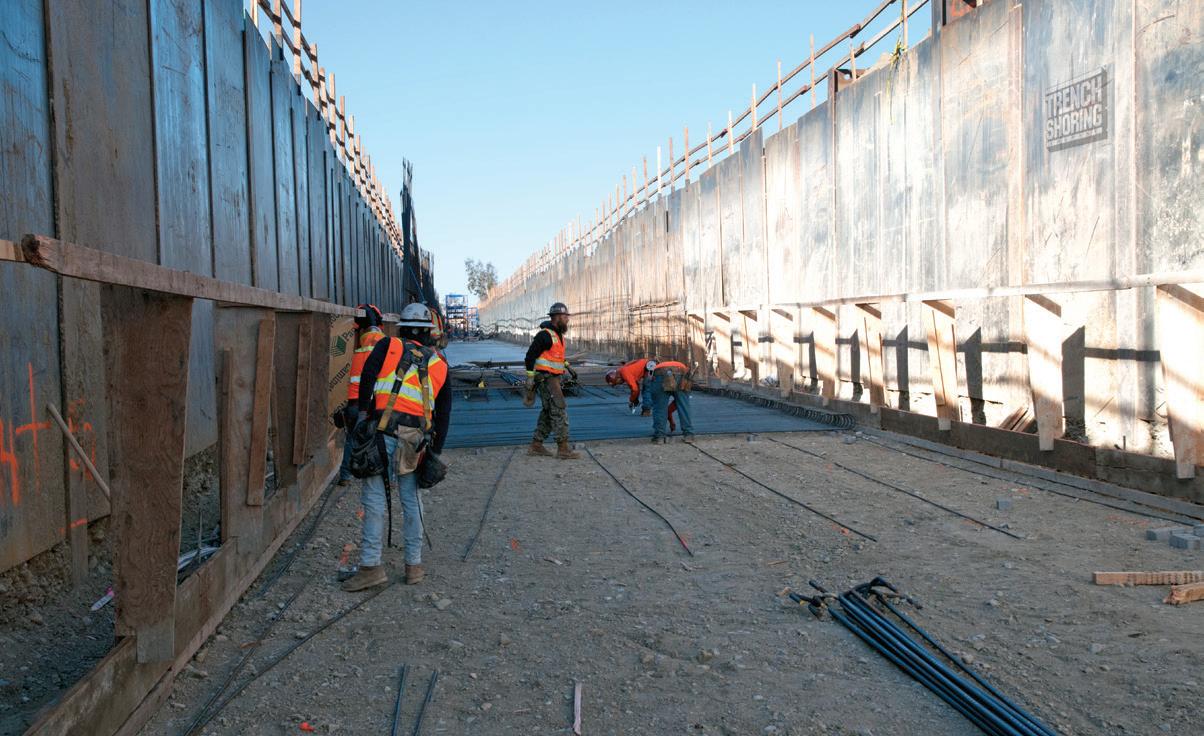
Pacific Steel Group (PSG) places 25,000 pounds of rebar a day.
Sukut’s portion of the work comes in at just under $60 million, with a total project length of 3.1 miles. Steve Reiser is the project manager overseeing this extensive flood control channel job that will include connections for future storm drain laterals. “The area in question is currently operating as a surface flow system, and our work will allow the City and County to construct a new storm drain system that will eventually empty into the newly constructed West Fontana Channel,” says Reiser. “The sequence of construction is to install temporary shoring along both sides of the channel, excavate, pour the bottom of the channel, pour the walls, and then backfill the void after removing the shoring beams and plates.”
Sukut is working with Trench Shoring Company for the rental of the plates used on the shoring on the West Fontana Flood Reduction Project. “We are using plates from Trench Shoring Company with approximately 3,300 linear feet of trench being opened and shored at any given time,” says Reiser. “We begin by driving the 40-foot long beams into the ground and then place the plates between the beams. We have worked with Trench Shoring Company on many projects over the years, and it is always an enjoyable, productive relationship.” The number of beams and plates needed for this particular project is staggering. Trench Shoring Company provided (800) 8x15R plates and Sukut purchased the beams. Trench Shoring Company did rent them various I-Beams, Shields, K-Rail and Hydraulic Jacks for specific Applications throughout the job. Trench Shoring Company is known for having one of the largest inventories of shoring products on the West Coast. They are equally recognized for their knowledgeable and courteous sales and dispatch team members,along with their on-time delivery and service.
Although the West Fontana Flood Reduction Project is a relatively simple and straight forward construction process, it is certainly not without challenges. “The channel is located between an active rail yard with trains running on one side and residences and businesses on the other. Access is extremely tight, and we are required to install temporary shoring throughout the 3.1-mile project,” says Reiser. “The access points are limited with a single-lane road on either side of the channel, and in most cases, those roads are not continuous. We have to be creative and organized to ensure that we maintain constant access for the nearly constant construction traffic.”
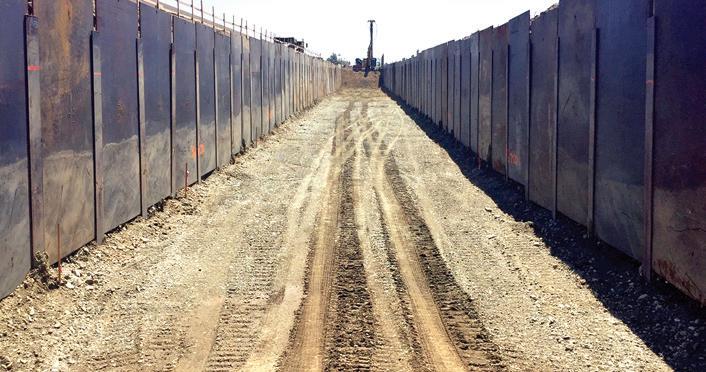
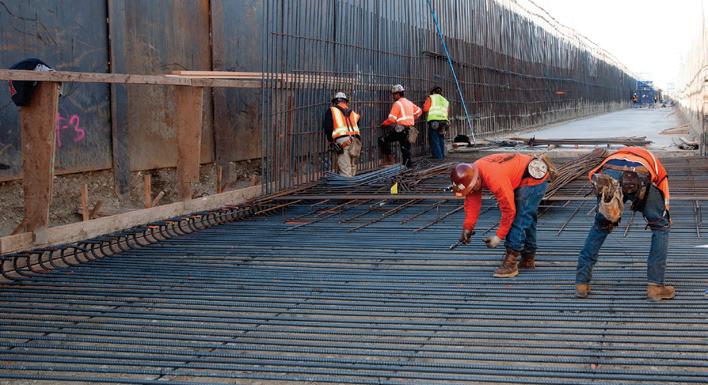
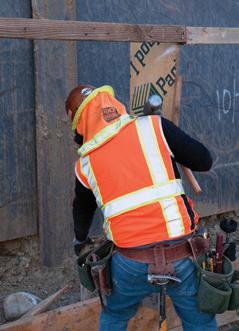
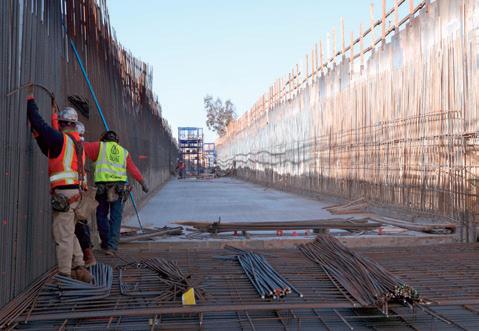
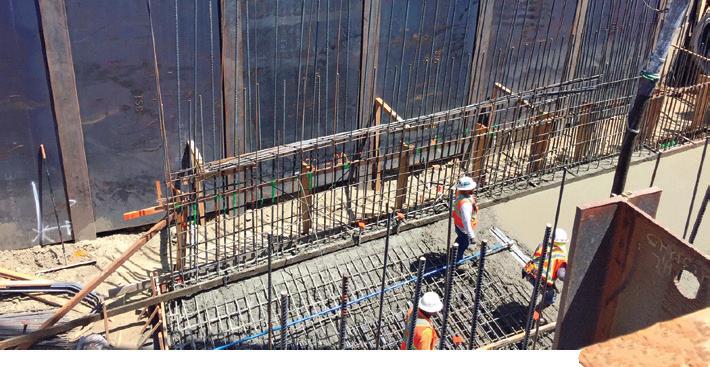
Reiser points out that his team will excavate and export around 300,000 cubic yards of dirt and pour more than 40,000 cubic yards of structural concrete that is reinforced by 3.75 million pounds of steel. “We are excavating the new channel down to a depth of 18 feet and around 12 to 25 feet in width, depending on the area in question,” says Reiser. “We are also installing nearly 2,000 linear feet of concrete box culverts as part of the project.” When complete, the new West Fontana Channel will convey up to 5,486 cubic feet of stormwater per second, which amounts to 41,000 gallons per second. It will also serve as a water quality and groundwater recharge device, as well as serving as a natural habitat green belt visible to Metrolink passengers.
In the great state of California, it is not a question of if massive flooding will occur, but only a matter of when it will happen. The State of California has spent the past 150 years building a complex system of levees, weirs, bypasses, dams, reservoirs, and other features to protect urban and rural areas against flooding. The ultimate purpose of such structures is the protection of life and property. The improvements to the West Fontana Channel are another positive step toward this end. Cc



